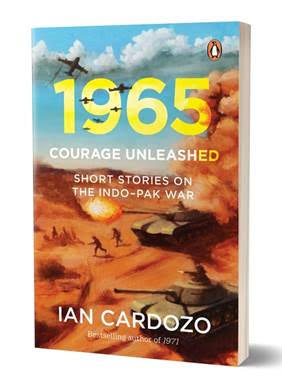On 15th August | Independence Day Special
1965 | Courage Unleashed
Did you know that the 1965 Indo–Pak War was initiated by Field Marshal Ayub Khan of Pakistan in an effort to wrest Jammu and Kashmir (J & K) from India? His failure to achieve his aim led eventually to his overthrow.
The Indo–Pak war of 1965 started as a localized conflict in J & K and exploded into a complex all-out war fought on a much bigger scale than the wars of 1947–48, 1962, 1971 and 1999. It extended from Ladakh in the north to Bikaner in Rajasthan and across the states of J & K, Punjab, Rajasthan and West Bengal. In extent, what was handled by the Western Command in 1965 is being handled today by three commands.
This account highlights the human dimension of war through the dramatic personal experiences of army and air force officers that astonish and overwhelm one’s imagination. It will convince the reader that real life is often stranger than fiction. The book also brings to light little-known facts that occurred across land, sea and air.
Major General Ian Cardozo was commissioned at the Indian Military Academy into the 1st Battalion of the 5th Gorkha Rifles (Frontier Force), where he received his basic grounding as a young officer. Thereafter, he took part in the Sino–Indian war of 1962, the Indo–Pak war of 1965 and the Indo–Pak war of 1971.
On 28 August, the Battle of Haji Pir | Indo-Pak War on 1965
In August 1965, 30,000 Pakistani infiltrators crossed the Cease Fire Line (CFL) in Kashmir and began attacking civilians and army personnel. Codenamed ‘Operation Gibraltar’, this assault involved a mix of trained militia, mercenaries and Pakistani army personnel. Amidst the devastation, Indian forces retaliated and captured the strategic Haji Pir Pass.
- At the heart of “The Battle of Haji Pir” lies the duality of victory and loss in warfare.
- Explores the profound bravery and determination of Indian soldiers who fought to secure the Haji Pir Pass, highlighting their unwavering commitment and heroism.
- Delves into the complexities of international diplomacy and the often-painful concessions made for peace, offering readers a poignant reflection on the true cost of war and the enduring legacy of those who serve on the front lines.
- Kulpreet Yadav meticulously documents the Indian Army’s exceptional counter-move to Pakistan’s Operation Gibraltar plan to destabilize Kashmir.
The triumph however was short-lived as the pass was returned under the Tashkent Agreement, a bitter pill for the soldiers who had fought tirelessly for it. The Battle of Haji Pir by Kulpreet Yadav chronicles their courage and sacrifice, offering a poignant glimpse into the lives of those who won the Haji Pir Pass, a symbol of both victory and loss for India.

If you’ve longed for a book explaining terrorism and conflict that goes beyond simplistic tropes of “good vs evil”, start here
The Company of Violent Men: Stories from the Bloody Fault lines of the Subcontinent by Siddharthya Roy
An unflinching and deeply personal narrative, takes readers on a journey through some of the most turbulent regions in South Asia, revealing the nuanced and often overlooked human stories behind the headlines.
From the Rohingya refugee camps in Bangladesh plagued by drugs and human trafficking, to the dense forests of Chhattisgarh where Maoist rebels and the Indian State are locked in a half-century-long conflict, and the volatile region of Kashmir caught between India and Pakistan, Roy’s book paints vivid portraits of life amidst chaos. The stories are told poignantly with raw emotions that reveal a cyclical pattern of brutality against ordinary individuals caught in the web of exploitation by those in power.
From a genocide survivor—a little girl—who asks for nothing more than a hot meal to an aspiring suicide bomber with cannabis-laden dreams of global destruction, Roy paints kaleidoscopic and haunting portraits of mercenaries and middlemen, refugees and insurgents—each complex and morally ambiguous. As he navigates the minds of others, Roy often turns the lens inward with uncompromising honesty, examining his own evolution as a journalist and the ethical dilemmas he faces.
This part memoir, part reportage, crackles with the urgency of war dispatches. And yet, pausing and meditating, it peels back hurried headlines, making readers bear witness to what the reporter saw when he ‘looked beyond the burqa and the beard, beyond the olive-green of one fighter and the camo fatigue of the other, and talked to the humans who wear these facades’.
It was against the backdrop of these disillusionments with the new 24×7 news cycle that Roy’s writing allowed for a much more soulful examination of the conflicts he covers. He extricates the humans clothed behind the ideological rhetorical veil to unfold the hurried headlines, respecting the common fragility of people caught in violent struggles as a “fellow voyager on the same turbulent waters.” This book challenges readers to look beyond stereotypes and simplistic narratives, urging them to understand the complex realities of those living in conflict zones.





